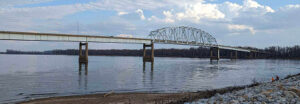
The American Flood Coalition this month convened county staff, elected officials, and state agency representatives for its High Country Flood Resilience Tour — a tour of several sites in Western North Carolina at risk of flooding.
The tour, which was held in partnership with the High Country Councils of Government, highlighted the unique flooding challenges faced by communities in the High Country of North Carolina. State officials heard about flood risk in the region, and local leaders learned ways to access and leverage resources, many of which are funded by the recently passed North Carolina budget.
“Flooding is truly a statewide challenge,” said AFC Carolinas Director Tony McEwen. “We all understand how critical flooding is in eastern North Carolina, but few know the significant flood risk faced by communities across the western portion of our great state. The American Flood Coalition values the opportunity to shine a light on the needs of communities faced with flood-related challenges.”
AFC connects leaders at all levels to build resilience

As the only organization that works on flood solutions across local, state and federal levels, AFC is uniquely positioned to convene this type of group. With an event like this, local leaders could share challenges with flood impacts directly with state officials.
Attendees included local mayors, county executives, county commissioners, and emergency managers. Additionally, the event featured remarks by state agency officials, including those from the North Carolina Office of Recovery and Resiliency, North Carolina Department of Environmental Quality, North Carolina Emergency Management, North Carolina Department of Agriculture, Golden Leaf Foundation, and more.
Also in attendance were senior staff from congressional offices and North Carolina Senator Ralph Hise. Senator Hise represents a sprawling district of nine counties in the region and serves as the senior chair of the influential Senate Appropriations Committee.
Stop #1: Flooding challenges amid population growth and related development

The first stop on the tour was the Boone Mall. This site exemplified one of the major challenges in Boone: Balancing the needs of a growing population and related development with resilient infrastructure that protects against flooding.
“We see the growth of Watauga County and Boone,” said one county commissioner. “And with that comes pavement. And with that comes flooding problems.”
Located at the confluence of three major creeks, the Boone Mall deals with regular flooding of its parking lot. Part of that flooding stems from the infrastructure: The creeks go through many culverts, which can be overwhelmed by heavy rainfall and are prone to clogging from sediment building up.
“Our infrastructure is not meeting our demand at the moment,” said Brandon Wise, an environmental specialist with the town of Boone. “How many frequent storms we’re having, how many storms we’re getting. We’re hitting a roadblock.”
The town has a state grant to study the area and come up with a solution. One such solution is daylighting, said Wise. By uncovering the top of a creek, rather than funneling it through a pipe, daylighting gives floodwaters more places to go.
Stop #2: When mountains lead to flash floods

The second stop on the tour was the original Mast General Store in Valle Crucis. Attendees heard about frequent flooding and road closures near the store, as well as impacts to the nearby airport, hospital, and school, along with the roads that lead to them.
Dealing with flooding is especially challenging in Valle Crucis, where the steep terrain makes flash floods more common. As rain falls onto the mountains, the water quickly flows downhill through small streams and creeks that eventually converge into the major rivers. When it rains hard enough, communities along these waterways are in danger.
County representatives stressed the need for funding to study and identify the sources of flooding and ways to limit road closures. They also pointed to stream bank restoration as a solution, though acknowledged that it’s very costly for local governments.
Another need is the removal of stream debris: During intense storms, trees fall over, debris and trash pile up, and roads and bridges become blocked — all of which can increase floods.
Stop #3: The need for state and federal funds

The event ended with a conversation facilitated by the American Flood Coalition at the High Country Council of Governments offices, where attendees heard from county staff, elected officials, and state agency representatives.
Seven counties and a few towns, including Boone, each highlighted their need for flood-resilient infrastructure and more state and federal support.
“I just want to thank you and the American Flood Coalition for putting this together,” said one of the planning directors in attendance. “It’s good to be able to sit with minds that are dealing with the same problems and see things from an outside perspective.”
A representative from the North Carolina Department of Environmental Quality presented on the state’s Flood Resiliency Blueprint. The Blueprint will cast a long-term vision for the state’s flood resilience by laying out a statewide set of projects and funding strategies.
Representatives from the American Flood Coalition presented on AFC’s Flood Funding Finder, a tool that simplifies the complex federal grants system and helps communities, especially small ones, identify the right federal funding programs to fund flood resilience.
“Putting together a coalition like this, and putting together groups that are able to work together and help each other with resources is just a huge boon to us,” said Boone Mayor Tim Futrelle, who became an AFC member after the event. “We’re really pleased and so grateful for what the American Flood Coalition is doing and how they’re working with us.”






